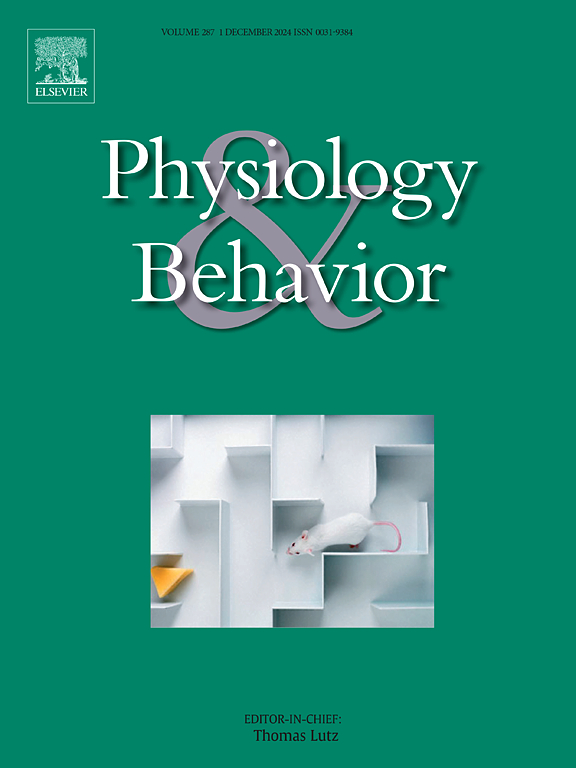Measuring shifts in attentional bias following satiety: A within-subject eye-tracking study in healthy-weight adults
IF 2.5
3区 医学
Q2 BEHAVIORAL SCIENCES
引用次数: 0
Abstract
Hunger and satiety are key physiological states that regulate food intake and contribute to the maintenance of body weight. Identifying appetite phenotypes, such as reduced satiety sensitivity, holds significant potential for developing personalized prevention and treatment strategies for obesity. However, a key challenge in obesity research is the lack of objective, quantitative tools to measure the physiological states of hunger and satiety. We developed the Food Attentional Bias (FAB) task, a novel, free-viewing eye-tracking paradigm designed to capture shifts in attentional bias toward food. In this study, we investigated within-subject changes in attentional bias toward food before and after eating in a cohort of healthy-weight individuals (N=57) using the FAB Task. Our results indicate a marked decrease in dwell time to food stimuli after eating, regardless of BMI, sex, or age. A linear mixed model for relative dwell time revealed a significant interaction effect between the area of interest (AOI) category and meal condition (premeal vs postmeal) on dwell time (F(4, 5538) = 23.011, p < .001). Post hoc comparisons for the AOI * Meal interaction revealed that the dwell times for food AOIs were significantly greater premeal than postmeal (mean difference = 0.070, p < .001). These findings suggest that as the body’s satiety signals increase postmeal, the motivational value of food decreases, leading to a reduction in attentional bias toward food stimuli. This dynamic recalibration of attention may act as an objective physiological marker of satiety, illustrating how internal physiological states influence attention allocation following food consumption.

测量饱腹感后注意偏倚的变化:健康体重成人的受试者眼动追踪研究。
饥饿和饱腹感是调节食物摄入和维持体重的关键生理状态。确定食欲表型,如饱腹感降低,对于制定个性化的肥胖预防和治疗策略具有重要的潜力。然而,肥胖研究的一个关键挑战是缺乏客观、定量的工具来测量饥饿和饱腹感的生理状态。我们开发了食物注意偏差(FAB)任务,这是一种新颖的、自由观察的眼球追踪范式,旨在捕捉对食物的注意偏差的变化(我们应该添加与其他刺激的比较吗?)在这项研究中,我们使用FAB任务调查了一组健康体重个体(n=??)在进食前后对食物的注意偏倚的受试者内部变化。我们的研究结果表明,进食后对食物刺激的停留时间明显减少,与平衡状况、BMI、性别或年龄无关。相对停留时间的线性混合模型显示AOI(兴趣区域)类别对停留时间有显著影响(F(4,5538) = 43.520,p < .001)。对AOI *膳食相互作用的事后比较显示,食物AOI在餐前的停留时间显著大于餐后(平均差异 = 0.070,p < 0.001)。这些发现表明,当身体的饱腹感信号在餐后增加时,食物的激励价值就会降低,从而导致对食物刺激的注意偏向减少。这种注意力的动态重新校准可以作为饱腹感的客观生理标记,说明内部生理状态如何影响食物消耗后的注意力分配。
本文章由计算机程序翻译,如有差异,请以英文原文为准。
求助全文
约1分钟内获得全文
求助全文
来源期刊

Physiology & Behavior
医学-行为科学
CiteScore
5.70
自引率
3.40%
发文量
274
审稿时长
47 days
期刊介绍:
Physiology & Behavior is aimed at the causal physiological mechanisms of behavior and its modulation by environmental factors. The journal invites original reports in the broad area of behavioral and cognitive neuroscience, in which at least one variable is physiological and the primary emphasis and theoretical context are behavioral. The range of subjects includes behavioral neuroendocrinology, psychoneuroimmunology, learning and memory, ingestion, social behavior, and studies related to the mechanisms of psychopathology. Contemporary reviews and theoretical articles are welcomed and the Editors invite such proposals from interested authors.
 求助内容:
求助内容: 应助结果提醒方式:
应助结果提醒方式:


